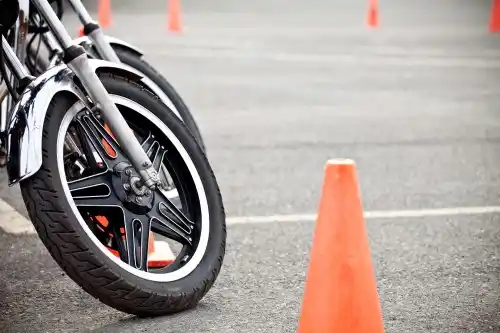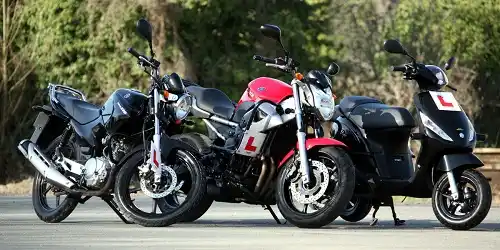Book motorcycle training in Manningtree, Essex with any of the companies listed here
Click on any of the motorcycle training schools below to view more information and check availability.
Excel Motorcycle Training Colchester
John Banks Honda, Severalls Industrial Park, Colchester, Essex, CO4 9HS
Approx. distance: 6.2 miles
Global Motorcycle Training Colchester
Rota House, Cowdray Avenue, Colchester, Essex, CO1 1YA
Approx. distance: 7.2 miles
All Bikes Motorcycle Training Ltd Colchester
Weston Homes Community Stadium, United Way, Mile End, Colchester, CO4 5UP
Approx. distance: 7.3 miles
Phoenix Motorcycle Training Colchester
The TA Centre, Circular Road East Lower, Colchester, Essex, CO2 7SZ
Approx. distance: 8.3 miles
Camrider Ipswich
Lindbergh Community Site, Lindbergh Road, Ipswich, Suffolk, IP3 9QX
Approx. distance: 8.6 miles
Suffolk Rider Training Ipswich
Unit 17, Dales Road Business Centre, Ipswich, Suffolk, IP1 4JP
Approx. distance: 9.6 miles
Manleys Motorcycles Clacton
4 Ford Road, Clacton on Sea, Essex, CO15 3DS
Approx. distance: 11.1 miles
Benson Motorcycle Training Braintree
1 Bocking End, Braintree, Essex, CM7 9AE
Approx. distance: 22.3 miles
Camrider Diss
Eye Airfield, A140 Ipswich Road, Brome, Eye, Suffolk, IP23 8AW
Approx. distance: 27.1 miles
Pass Bike Motorcycle Training Southend
Yard 2, 8 Purdeys Way, Rochford, Essex, SS4 1NE
Approx. distance: 29.5 miles

Have you been hunting for motorcycle training in Manningtree, Essex?
Have you been on the hunt for a company that can help you organise motorcycle training in Manningtree or nearby in Wivenhoe, Dovercourt and Colchester? Whilst price is important, the most important factor is the quality of motorcycle training. Book CBT Now has the largest listing of all motorcycle training companies in the UK. Simply enter your postcode and we will show you all of your local training companies that run motorcycle training and testing.
What are the different types of motorcycle licence I can get in Manningtree?
There are 4 main types of full motorcycle licence issued by the DVSA. The first three (AM, A1 and A2 motorcycle licences) have restrictions on the type of moped or motorcycle you can ride, the fourth (the full A motorcycle licence) has no restrictions.
The AM restricted moped licence
The A1 restricted motorcycle licence
The minimum age to take this test is 17. According to the DVSA website it will allow you to ride a "Light motorcycle up to 11 kW (and a power-to-weight ratio not more than 0.1 kW per kg) and 125 cc". This means it's up to a 125 cc motorcycle with some restrictions to make sure it cannot accelerate too fast - a really good idea when you are new to riding a motorbike!
Requirements to take the A1 motorcycle test - You must have a UK provisional or full driving licence, a valid theory test certificate and a valid CBT certificate. Once you have taken this test you will not have to keep renewing your CBT certificate every 2 years, you can ride on motorways and you can take a pillion passenger on the back of your motorbike.
The A2 restricted motorcycle licence
For this licence you need to be at least 19 years of age, have completed your CBT or have had an A1 licence for at least 2 years. As with the A1 test you also need to have a UK provisional or full driving licence and a valid theory test certificate . The main benefit of getting an A2 licence is you can ride a more powerful motorcycle. The law states a "standard motorcycle up to 35 kW (and a power-to-weight ratio not more than 0.2 kW per kg)". So it's a more powerful bike, but still not completely un-restricted. To find A2 legal motorbikes you are best visiting your local motorcycle dealer and asking them to show you the A2 legal bikes, as otherwise it's very difficult to work out just looking at the tech specs.
The full A motorcycle licence, or DAS licence.
This is the licence that allows you to ride almost any motorcycle without restrictions, so it's the ultimate motorcycle licence. No limits on power outputs or power per kg or engine size! It is also called a 'DAS' licence as it can be obtained from the 'Direct AccesS' route. There are two ways you can get this licence:
1) If you are 24 or over you can take the tests for an A licence. You must also have a UK provisional or full driving licence, a valid theory test certificate and a valid CBT certificate.
2) If you are at least 21 years of age and you have held an A2 category licence for at least 2 years. This is sometimes referred to as the 'progressive access' route as you progress from one licence to another.
When taking the test the biggest difference is that you have to use a bigger, more powerful motorcycle. It will have a power of at least 40kw and an engine cc of at least 595 cc. Your local training school will make sure you have the right size bike for your test.
There is also a flowchart (click here) that the DVLA have produced that shows these different licences and how to obtain them.
To get more detailed guidance on what licence is right for you then talk to your local motorcycle training school. You can search for them here and they are qualified to speak to you on the right type of training for you.
What can I ride in Manningtree when I am 16?
When you are just 16 years of age your choices are more limited. There is a special category of licence called the 'AM' licence (derived from 'A' licence for 'M'opeds) that you can take when you are just 16 years old. You can of course, take it when you are older too, but it's the only full license available if you are under 17 years of age. You will still need to do all of the components of a full motorcycle test, namely your theory and hazard perception tests, your compulsory basic training (CBT), your module 1 off road test and your module 2 on road practical test.
This licence allows you to ride a moped of 50 cc or less which has a top speed of 28 mph, with a passenger and without Learner plates. If you are only interested in riding a moped and nothing more then this licence could be right for you. If you want to ride a more powerful motorcycle then you might find it better to wait until you are 17. From the age of 17 onwards you can take the A1 motorcycle test which allows you to ride motorcycle up to 125 cc and with some restrictions on its power to weight ratio.

What are module 1 and module 2 tests?
These tests, often abbreviated to 'mod 1' and 'mod 2' are the two practical tests you must pass to get your full motorcycle licence. They are both run by the DVSA, not your local motorcycle training company. Your local motorcycle training company may be able to book them on your behalf and then book your training to fit around your test dates. If you do book these tests directly with the DVSA your local motorcycle training company will still make every effort possible to get you the correct training to fit in with your test dates.
The module 1 (mod 1) test
You can view a video from the DVSA all about the module 1 test here. This test normally takes about 20 minutes and is taken in a completely off road setting. You will be taken to a large tarmac area where you will need to demonstrate your ability to carry out the following manoeuvres:
- wheeling the moped or motorcycle and using the stand
- riding a slalom and figure of 8
- a slow ride
- a U-turn
- cornering and a controlled stop
- cornering and an emergency stop
- cornering and hazard avoidance
Once you have completed the test you will be told if you have passed or failed. You must pass the module 1 test before taking the module 2 test. Therefore be careful when you book, as if your module 2 test is too soon after your module 1 test and you fail the module 1 you will not be able to take your module 2 test.
The module 2 (mod 2) test
You can view a video from the DVSA all about the module 2 test here. This test involves riding on road and takes about 40 minutes in total. You will need to carry out the following things:
- an eyesight check
- show me, tell me vehicle safety questions
- road riding
- independent riding
You must bring your module 1 pass certificate to the module 2 test, you cannot take the module 2 test without a module 1 pass certificate.
The eyesight check involves reading a number plate from 20 metres away. 'Show me, tell me' is where you will be asked 2 vehicle safety questions from this list. As well as answering you must show the examiner what you are talking about by demonstrating it on the motorcycle. With the road ride the examiner will give you instructions through a radio link and will normally follow you on a motorcycle to observe your riding. The last 10 minutes will be independent riding which is designed to assess your ability to ride safely while making your own decisions. After telling you a set of directions you will be expected to carry them out safely and independently.
How do I get the right training in Manningtree for the A2 motorcycle licence?
The A2 motorcycle licence is a restricted licence you can get when you are 19 or over. It is popular amongst 19 to 24 year olds as it is the only licence that allows you to get on a more powerful motorcycle at that age. It is essential that you get the right training for this licence as without it you are likely to hurt yourself or even worse, someone else. Use this websiteto enter your postcode and search for your local motorcycle training school. They are all fully qualified to advise you on the training you will need. Although saving money is something everyone wants to do, the right training will save your life. Therefore don't just focus on price, look at the quality of training on offer and the standard of training.